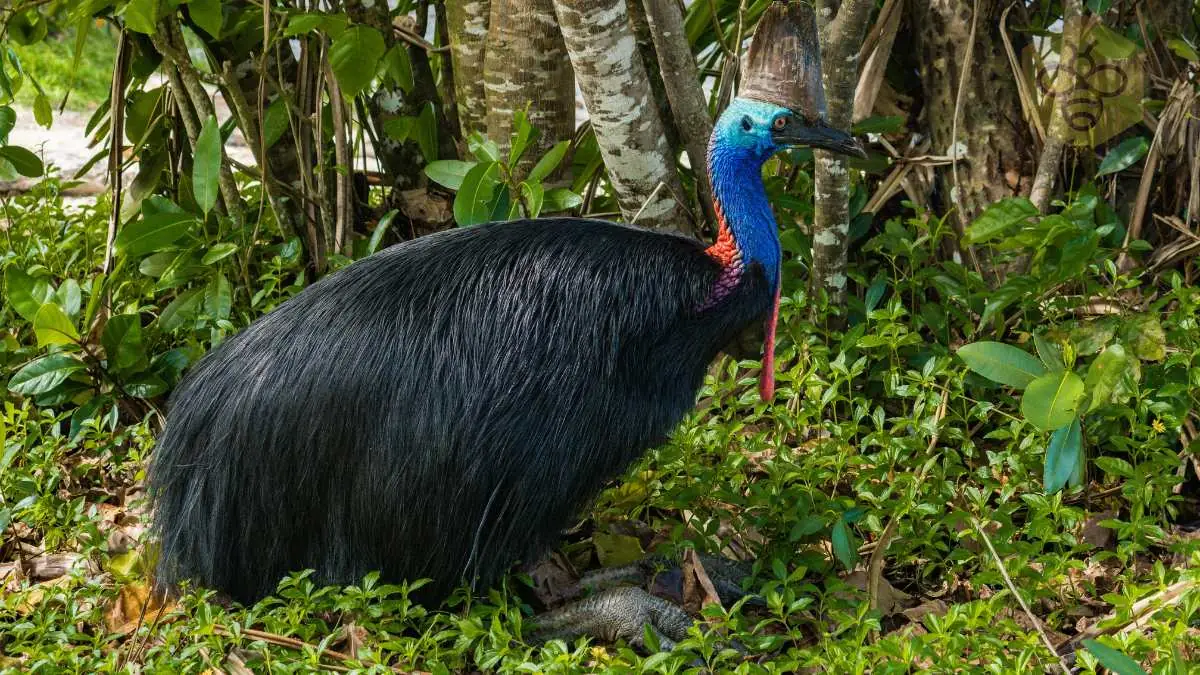Cassowary: The Mysterious and Powerful Bird of the Rainforest
Cassowary
Introduction
The cassowary is one of the most fascinating and dangerous birds in the world. Native to the rainforests of Australia, New Guinea, and surrounding islands, this large, flightless bird is known for its striking appearance, powerful legs, and aggressive nature. Cassowaries play a crucial role in their ecosystems by spreading seeds and maintaining rainforest biodiversity.
Scientific Overview
Scientific Name
Genus Casuarius
Common Name
Cassowary
Scientific Classification
| Kingdom | Animalia |
| Phylum | Chordata |
| Class | Aves |
| Order | Casuariiformes |
| Family | Casuariidae |
| Genus | Casuarius |
Types of Cassowaries
There are three main species of cassowary:
- Southern Cassowary (Casuarius casuarius) – The largest and most well-known species, found in northern Australia and New Guinea.
- Northern Cassowary (Casuarius unappendiculatus) – Found in New Guinea, slightly smaller than the southern cassowary.
- Dwarf Cassowary (Casuarius bennetti) – The smallest species, found in mountain forests of New Guinea.
Habitat and Distribution
Cassowaries are found in tropical rainforests, mangroves, and swampy areas in:
- Australia – Northern Queensland.
- New Guinea – Both Papua New Guinea and Indonesian Papua.
- Nearby islands – Including the Aru and Seram Islands.
They require dense forests with plenty of fruit-bearing trees for food. Habitat destruction poses a significant threat to their populations.
Physical Characteristics
Size and Weight
- Height: 5–6.5 feet (1.5–2 meters).
- Weight: 55–130 lbs (25–60 kg).
- Lifespan: 40–50 years in captivity, around 20 years in the wild.
Appearance
- Bright blue head and neck – Helps with camouflage in the rainforest.
- Large casque (helmet-like structure) on the head – Possibly used for communication, protection, or pushing through dense foliage.
- Sharp claws – Each foot has a dagger-like claw up to 4 inches (10 cm) long, capable of inflicting serious injury.
- Strong legs – Powerful enough to run at speeds up to 31 mph (50 km/h) and jump up to 7 feet (2 meters).
Diet and Feeding Habits
Cassowaries are omnivores but primarily frugivores (fruit eaters). Their diet includes:
- Fruits (over 150 different types, including toxic ones safe only for cassowaries).
- Leaves, fungi, and flowers.
- Small animals, insects, and carrion (occasionally).
They are key seed dispersers, as some rainforest plants rely on cassowaries to spread their seeds over large areas.
Predators and Threats
Adult cassowaries have few natural predators due to their size and strength, but threats include:
- Dingoes (in Australia).
- Large pythons (occasionally prey on young cassowaries).
- Human-related threats such as habitat destruction, vehicle collisions, and dog attacks.
Reproduction, Babies, and Lifespan
- Mating season: June to October.
- Eggs laid: 3–6 large, bright green eggs.
- Incubation: 50 days, with males incubating the eggs and raising the chicks.
- Chicks stay with the father for about 9 months before becoming independent.
Cassowary fathers are dedicated parents, fiercely protecting their young from predators.
Population and Conservation Status
- IUCN Red List Status: Vulnerable (Southern Cassowary).
- Main threats: Deforestation, road accidents, dog attacks, and hunting.
- Conservation efforts: Protected areas and breeding programs in Australia and New Guinea.
Behavior and Lifestyle
- Solitary animals – Except during mating and when raising chicks.
- Highly territorial – Can be aggressive if threatened.
- Excellent swimmers – Can cross rivers and swim well.
- Capable of powerful kicks – Can defend themselves with their sharp claws.
Ecological Role
Cassowaries are critical seed dispersers in rainforests, helping to regenerate plant life and maintain biodiversity. Without them, certain tree species might struggle to reproduce.
FAQs About Cassowaries
1. Are cassowaries dangerous to humans?
Yes, cassowaries can be dangerous if provoked. They can deliver powerful kicks and use their sharp claws in self-defense.
2. Can cassowaries fly?
No, cassowaries are flightless birds, but they are strong runners and swimmers.
3. Why do cassowaries have a casque on their head?
The casque may help with communication, protection, or breaking through dense vegetation.
4. How fast can a cassowary run?
Cassowaries can run up to 31 mph (50 km/h), making them one of the fastest large birds.
5. Why are cassowaries important to the environment?
They help maintain rainforests by spreading seeds, ensuring the growth of various tree species.
Conclusion
The cassowary is a fascinating and essential part of the rainforest ecosystem. Its striking appearance, powerful defense mechanisms, and vital role as a seed disperser make it one of the most unique birds on the planet. However, habitat destruction and human-related threats are putting this species at risk. Conservation efforts are crucial to ensuring that cassowaries continue to thrive in their natural habitats.
